Do you know how to responsibly execute a cosmetic product recall? There’s been some buzz recently in the clean beauty space after a well-respected, independent brand discovered that one of its most popular formulas isn’t stable. The development hit the airwaves last week, though the product has been beloved by editors and clean beauty fans from coast to coast for several years. The artisan took to their Instagram account and email list to announce that they’re temporarily halting sales while they investigate and reformulate though they stopped short of declaring a recall. I appreciate that this is a teachable moment for our industry, providing an opportunity to shed some light on the best cosmetic product recall procedure.
How to Responsibly Execute a Cosmetic Product Recall
A graduate of my cosmetic GMP class put the situation on my radar the day after our graduation, and I found the timing ironic. By way of background: I have both a depth of knowledge and an intense passion for the safety of natural cosmetics and ensuring a bright future for those who are pioneering this space. I spent fifteen years bootstrapping my beauty brand, implementing quality control systems, and building GMP-compliant production protocols. And I walked both the halls of Congress and the corridors of the FDA for several years, working as a small business advocate to encourage government stakeholders to keep small, independent beauty brands in mind as they craft new federal legislation. As a consultant to makers and product designers, I now teach GMP principles to other beauty brand owners.
Product recalls are an unfortunate reality of modern consumerism, and product recall examples are abundant. But there’s a particular cosmetic product recall procedure that needs to be followed.
MY CONCERNS WITH THE RECENT SCARE FROM A POPULAR INDIE BEAUTY BRAND
There’s a whirlwind of confusion about the requirements for creation and distribution of personal care products within the United States. I engaged in direct dialogue with this beauty entrepreneur during her announcement and our conversation only deepened my concerns.
- She elected not to use the word “recall” in any of the announcements that I could locate. That’s a critical keyword for this process and clarity is key.
- The message to customers included romanticized verbiage like “bloom” and “mild fermentation” rather than clear terms which accurately describe what’s happening with those products: mold and contamination. She later conceded privately that she made “some language mistakes.” While my recommendation for an updated statement with clear language apparently fell on deaf ears, I remain hopeful that she’ll make an additional public statement with clear instructions for her customers.
- When the brand owner addressed my concerns in the comments section of her Instagram post, she mentioned that she’d sold tens of thousands of units of this particular product over the years and affirmed that it “has always challenge tested stable.” She later reached out to me privately and said that the company was “undergoing challenge testing for all of [their] formulas as required by the EU regulatory system.” Those statements are contradictory and lead me to wonder if she understands the nature of these tests and when/why they’re required.
- When customers inquired on Instagram about whether the product in their possession was safe to use, the company expressed that continued use was “at their discretion.” Both those who hadn’t noticed mold and those who spoke of scraping the mold off the tops of their face mask received that same information. *shudder* This approach jeopardizes the health of customers while exposing the company to legal liability that’s simply not worth the cost of saving face.
BALANCING OUR DESIRE FOR NATURAL BEAUTY WITH THE PUBLIC’S NEED FOR SAFETY
Over the past few years, a host of bad actors have invited unwelcome attention and a sense of hysteria about cosmetic safety. I’m looking at you Claire’s, WEN by Chaz Dean, and Brazilian Blowout.

We’re the midst of a decade-long effort to overhaul federal cosmetics legislation, and some hardworking souls have invested hundreds of thousands of dollars and dozens of trips to Washington DC to advocate on behalf of this industry. But they can’t carry the entire weight of the industry themselves, and responsible beauty owners must rise to the occasion when a problem arises.
TESTING REQUIREMENTS FOR COSMETIC PRODUCTS
The FDA regulations are clear: hydrous formulas* should be challenge tested before they hit the market to ensure stability and adequate protection against contamination during regular use. A challenge test (or Preservative Efficacy Test- PET) ensures that a product won’t colonize mold, yeast or bacteria during normal conditions of use. It also determines the shelf life and ensures that the anticipated functionality and physical characteristics of the product are stable throughout that shelf life.
Once a formula has passed challenge testing, then each batch of that formula should be subjected to microbial testing before release to ensure that it was manufactured cleanly. The 1-2 punch of challenge testing and microbial testing guarantees that a) a formula is sound and will withstand the rigors of customer use and b) that every batch is safe and sanitary when it leaves the hands of the manufacturer.
When we thoughtfully and consistently observe these protections, then contaminated products can’t get into the hands of consumers. When products separate, grow mold or show signs of an infestation of bacteria, then there’s been a failure in some facet of the system, and quickly getting to the bottom of that failure is of utmost importance.
*A hydrous product is one which contains water or water-like ingredients, including aloe vera juice, honey, hydrosols, some botanical extracts and infusions, and distillates.
THE IMPORTANCE OF RESPONSIBLE ENTREPRENEURSHIP IN THE BEAUTY SPHERE
In reality, increased oversight will create barriers to entry, preventing future startups from launching. It also has the potential to shutter the most vulnerable brands in our industry, and I cringe at the thought of how a significant overhaul of federal legislation will impact small personal care companies. My goal in bringing these issues to light isn’t to injure any brand or our industry as a whole. Instead, I aim to protect an industry I love and the pioneering space that I’ve devoted the lion’s share of my career to nourishing. I deeply desire to safeguard indie beauty brands, their employees, their customers, and our industry as a whole.
With regard to the recent announcement of a contaminated face mask, there were other options available that would better inform and protect customers while limiting the company’s legal exposure.Let’s explore a better methodology for cosmetic product recall procedure.
WHAT IS AN FDA PRODUCT RECALL?
“A recall is a firm’s removal or correction of a marketed product that FDA considers to be in violation of the laws we administer and against which we would initiate legal action.” While the FD&C Act doesn’t give the FDA the authority to order a recall of a personal care product, the FDA does play a critical role in the recall process.
- The FDA can request the recall of a product. If they elect to take that action, then the FDA will develop a strategy for the cosmetic product recall procedure that outlines how they expect it to be executed. Generally speaking, the FDA expects brand owners to act ethically when a problem arises, executing their own recall before the FDA intervenes.
- The FDA will monitor the progress of a recall via a review of mandated progress reports from the manufacturer and/or periodic checks at retail locations to ensure a recall’s effectiveness.
- The FDA classifies the degree of hazard posed to the public by a recalled product, rating it as a Class 1 (most severe), Class II, or Class III (least dangerous).
- If the FDA determines that public notification is necessary, they can assure that the product manufacturer makes the proper notification. When a beauty manufacturer refuses to do so, the FDA may issue one on their behalf.
- The FDA ensures that the affected product is appropriately destroyed.
RESPONSIBLE COSMETIC PRODUCT RECALL PROCEDURE
Investigate immediately when you notice that something’s amiss with your products. Look for batches which unexpectedly change color, show signs of separation, display evidence of mold, or have unusual odors. You should test each batch of hydrous products for microbial contamination before release to the public. Any time those products don’t pass with flying colors, the product should be destroyed to prevent distribution.
If you follow proper GMP protocols, then you’ll catch the issue before the product winds its way into the hands of your customers. If your quality control systems fail, then follow these steps to develop your cosmetic product recall procedure:
- Halt sales of the product in question until you complete the discovery process and can ensure the safety of the products you distribute.
- Pull your retained batch sample, batch records, and microbial test reports associated with this specific product.
- Pour over those records to look for abnormalities.
- Send the retained batch sample to an independent lab for further testing.
- Pull your distribution records to determine where affected batches have been shipped and prepare a list of consumers and wholesale stockists who will need to be notified.
- Notify your liability insurance company of the product recall to confirm coverage and get feedback on next steps.
- Make the FDA aware of the impending recall and your plan for managing it.
- Issue a press release and communicate the issue to your customers and stakeholders. Use clear, accurate language. Be explicit about whether the product in question is safe for continued use. I invite you to review the press release associated with a recent product recall to see how responsible companies frame their public announcements.
- File periodic updates with the FDA so they can monitor the progress of your cosmetic product recall procedure.
ACTIONABLE STEPS FOR RESPONSIBLE BEAUTY BRANDS
If you take your responsibility as a beauty entrepreneur seriously (and I hope you do!), then this actionable to-do list will keep your feet on the right path and your company out of hot water.
- Educate yourself on proper formulation principles, rigorously test your products, and make sure that you’re working with reputable vendors for your raw materials and packaging.
- Understand the FDA cosmetic labeling regulations and ensure that you follow them to the letter.
- Practice Good Manufacturing Principles (GMP) when creating your products. Establish clear, well-documented systems and use them consistently. (Pssstttt… I offer a cosmetics GMP class that teaches how to design and implement those systems!)
- Keep detailed batch records. Retain samples of every product produced for a minimum of 24-36 months. Apply batch numbers to every product you release for sale. Make certain that you have the ability to track those batch numbers if you ultimately need to initiate a recall and notify affected parties.
- Develop a contingency plan for how you’ll handle a product recall. Develop that plan before the need arises for a recall.
- Get on record with the FDA by joining their Voluntary Cosmetic Registration Program.
- Create a system for managing product complaints. Cosmetic product complaints don’t encompass customer service issues or whether someone prefers a particular aroma. A true cosmetic product complaint is a concern about the safety of a product. Carefully document those complaints, including contact information from the complainant, the nature of the complaint, affected batch numbers, purchase details, and what action your company took to address the issue.
- Ensure that you carry adequate product liability insurance. I recommend at least $1 million in coverage, and the Indie Business Network offers affordable product liability insurance.
WHAT QUESTIONS DO YOU HAVE ABOUT COSMETIC PRODUCT RECALLS?
I encourage you to stay attuned to legislative developments and become an advocate for our industry. I’m so grateful that my lobbying buddy (and dear friend) Anne-Marie Faiola of Bramble Berry founded the Coalition of Handcrafted Entrepreneurs (COHE) to represent us and continue the advocacy work. Join the COHE mailing list and be willing to get involved if needed.

What questions do you have about cosmetic safety and testing and the cosmetic product recall procedure? Have you ever had a product scare? Do you have a cosmetic product recall procedure in place? I hope you’ll drop a comment below so we can continue the discussion!
P.S. Did you know that you can search the FDA database for product recalls?
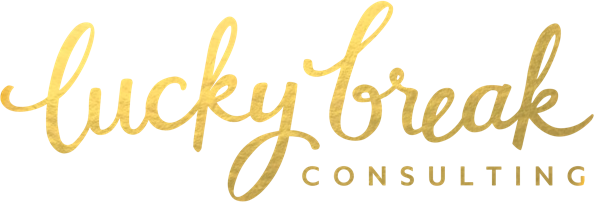
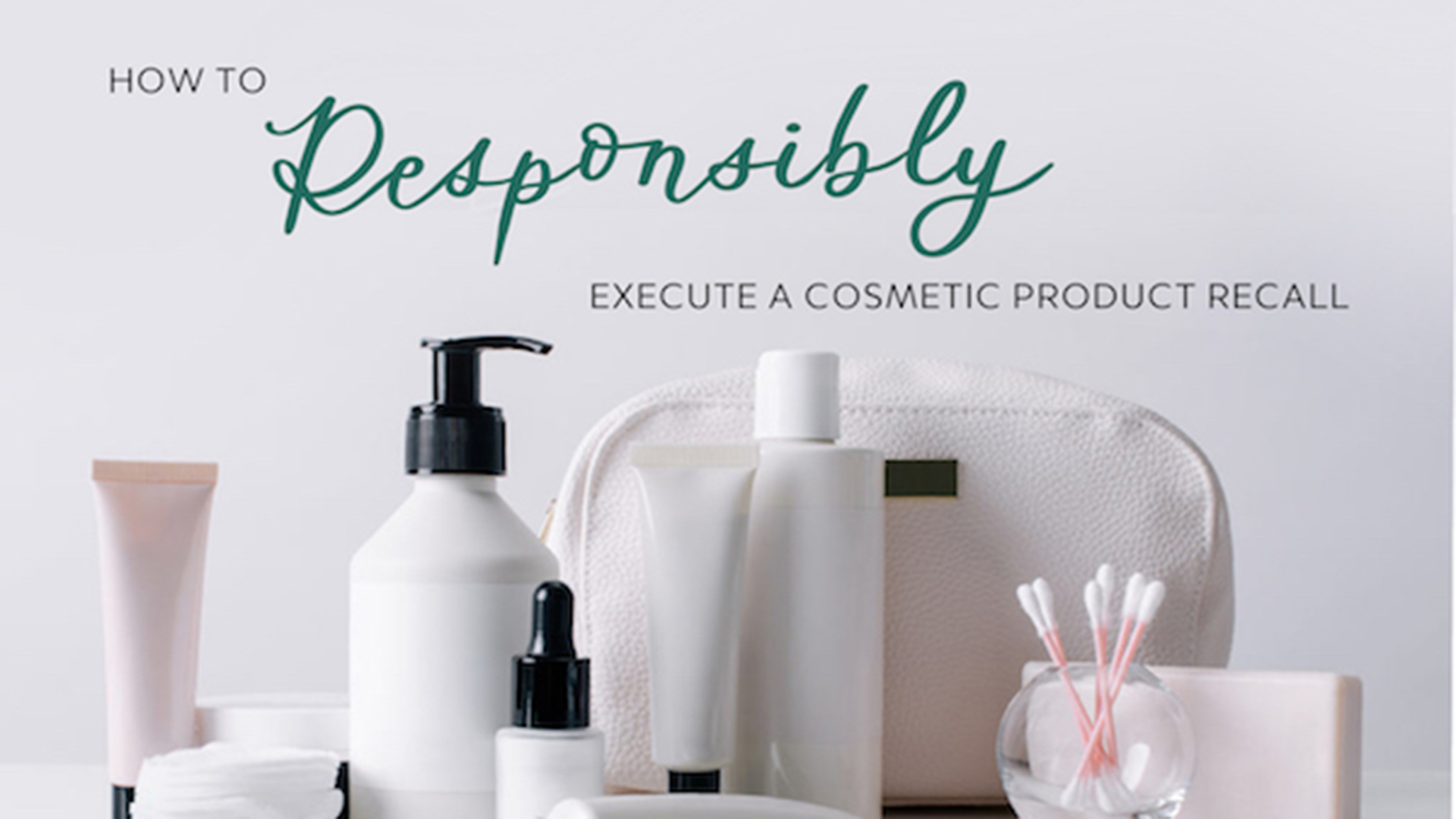

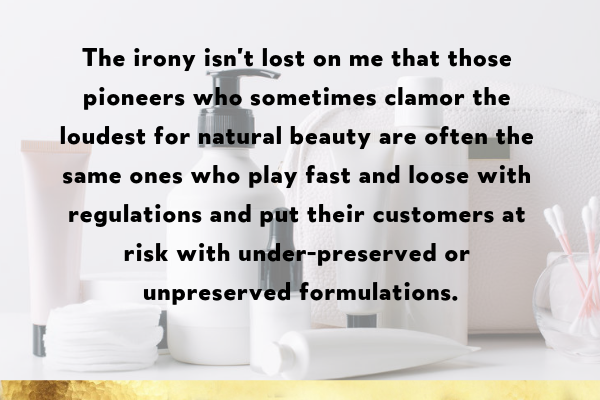
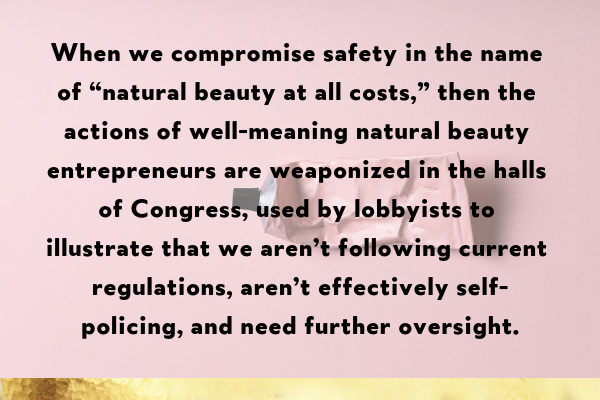
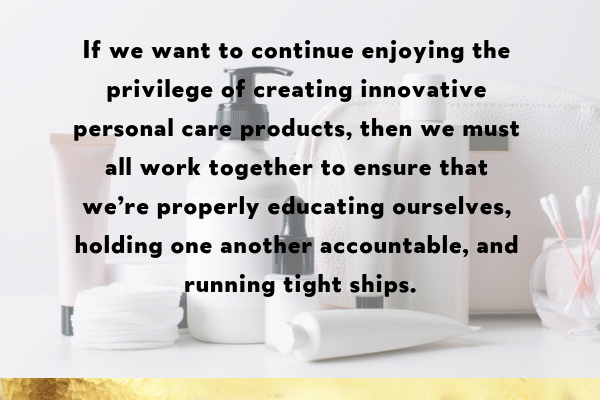
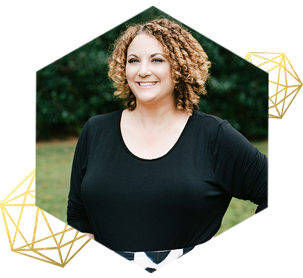



I think you might want to reconsider calling WEN a “bad actor” since nothing bad was found in or about the product. Shame on your for perpetuating well…lies. Did you even read the link you placed in your article? Southerner, indeed.
Hi Jug,
Let’s not insult an entire geographic region populated by millions of good people simply because you disagree with what I said about a haircare brand on the internet. The South is a lovely place and though we often bring up the rear culturally and politically, we do know how to read and count down yonder. Which is why I 100% stand by my characterization of WEN as a “bad actor.” I said it in my original post and I’ll say it again: WEN has caused serious damage to the beauty industry by their actions and I wish they’d conducted themselves differently.
Perhaps you missed this line of my post, which I’ll kindly direct your attention back to. >> “And I walked both the halls of Congress and the corridors of the FDA for several years, working as a small business advocate to encourage government stakeholders to keep small, independent beauty brands in mind as they craft new federal legislation.”
May I ask how many times you’ve been in the offices of federal legislators discussing pending cosmetic legislation? Or how many legislative aides have brought up the WEN situation to you when having those legislative discussions? Or maybe you’re willing to share how well-versed you are in cosmetic formulation, good manufacturing protocols, and proper recall procedures? Feel free to shine up those credentials and toss them out so that we can compare notes and have an informed discussion.
In the meantime, I stand by these facts, the first three of which were pulled directly from the article I linked to in my post, which you feel somehow exonerates WEN:
1. “Up to November 15, 2016, the FDA has received 1,386 reports from consumers. When the FDA inspected the manufacturing and distribution facilities for these products, we learned that consumers had reported reactions in more than 21,000 complaints submitted to Chaz Dean, Inc. and Guthy Renker LLC, the companies that market and manufacture the products.”
2. “Guthy Renker stated that since 2011, at least 66 percent of all reports specifically about hair loss have named the Sweet Almond Mint variety. The following varieties were named most often in reported reactions:
Sweet Almond Mint- 5,689 complaints
Lavender- 2,537 complaints
Pomegranate – 1,542 complaints”
3. “The FDA is in communication with the companies as part of an ongoing investigation.”
4. The fact is- by their own admission, WEN has received upwards of 20,000 complaints and they still haven’t initiated a voluntary recall. I wish the FDA had the power to force a recall… I see it as one of only a few weaknesses in the current cosmetic laws. And I walked the halls of DC for years speaking with legislators who were considering new legislation that would give the FDA that power, some of whom specifically mentioned that their actions were spurred by the WEN situation and the negative press it was spawning for an industry of incredibly hardworking cosmetic manufacturers, many of them small businesses. Need confirmation that WEN’s inaction was questioned by many and threatened the industry with bad press? Perhaps a headline story in a little rag called the NYTimes would suffice? >> https://www.nytimes.com/2016/08/16/us/politics/cosmetics-industry-congress-regulation-wen.html
Or maybe you prefer an article from WebMD under the headline “WEN Case Spurs Calls for Beauty Product Regs?” >> https://www.webmd.com/beauty/news/20180207/wen-case-spurs-call-for-beauty-product-regs
Or perhaps the fact that a WEN customer was paraded out by a Congressional committee which was looking into the overhaul of cosmetics legislation based on the experience of her losing her hair? >> https://www.youtube.com/watch?v=2WHTrEoKU1w
I stand by my assertion that WEN did itself, public safety, and the personal care industry no favors. They could and should have acted differently and they owed the public more than they offered. I regret that you disagree, but I’m wholly unmoved by your tantrum. I do, however, hold this blog and myself to a high standard. So if you do, in fact, see a “lie” in my original post, please let me know and I’ll follow up with diligence.
Hi there,
i read your blog and really impressed after your blog.
thanks for sharing valuable information
As an industry QA professional, this was an excellent read Lela…as well as the “read” to the poster Jug 🙂
Hey.
This is an excellent guide on cosmetic recall. Thanks for sharing.